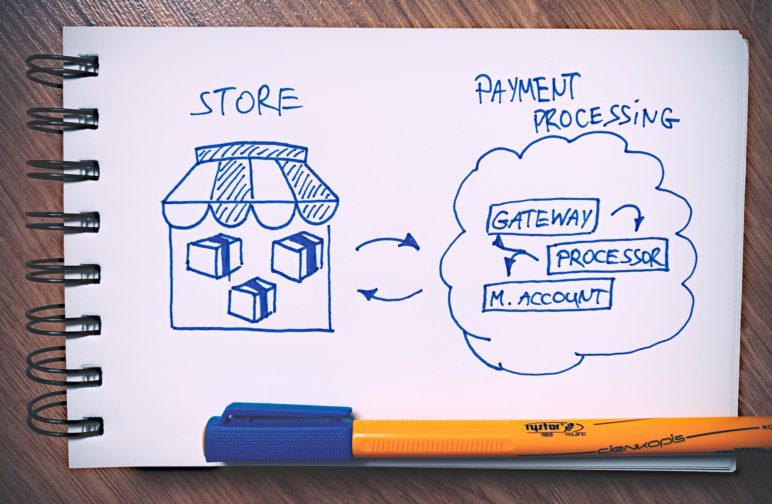


Although the benefits of credit cards are straightforward, the ecosystem of credit card payment processing is not. This is especially true for the new merchant or nonprofit organization in the early stages of credit card acceptance.
This “Credit Card Processing 101” eBook explains the components of credit card payment processing. Knowing the key players and how electronic payments work will help you ask the right questions to payment partners. As a result, you will be better prepared to create the system that is best suited for your needs and budget.
Credit Card Processing Players and Process
The first order of business for successfully accepting a credit card payment is to learn who the players are, and what actually happens from the moment a customer’s card has been swiped, keyed into a terminal, or entered into a web page, up to the moment the funds are transferred into your bank account.
Who Does What in this Complex System?
The Customer
The person who wants to use their credit card to pay you for your goods or services.
The Issuer
The Issuer is the entity or bank that grants credit to a Customer and issues a credit card . The Issuer typically partners with Visa or Mastercard . Discover and American Express are examples of private label cards that a Customer applies to directly.
The Merchant Provider
The bank or agent of a financial institution that supplies you with your merchant account is the Merchant Provider . Merchants negotiate an agreement with the Merchant Provider for the purpose of accepting credit cards . The Merchant Provider represents the Merchant’s interests and supports you through every step of the process — from installation to day-to-day service calls . The Merchant Provider also receives deposits through the Interchange Network from each Issuer and transfers them into the appropriate merchant accounts.
The Card Network
Visa, MasterCard, American Express and Discover make up what is referred to as the Card Network or “The Network”.
The Merchant
That’s you. A Merchant is any company that enables Customers to purchase goods or services using a credit or debit card.
The Processor
A Processor is an intermediary that enables transactions to flow through the system to obtain authorizations and deposits via the Interchange Network. There are several major Processors that facilitate this movement . In most cases, Merchants do not choose their Processor . It is usually determined as a result of which bank or financial institution your bank or Merchant Provider represents; however, this is transparent to you.
The Payment Gateway
A Payment Gateway is a software service and set of APIs that enable the Merchant to access the systems needed to transmit a request for payment . The moment card data is received via swipe, key, dip, or tap, the Gateway securely transmits the information via the Processor to the Issuer for authorization. The Issuer returns the authorization back to the Payment Gateway through the Processor.
4 Primary Steps of a Credit Card Processing Payment Transaction
Payment
When a Customer uses a credit card to pay for your goods or services, or make a donation, the transaction must be authorized by the bank that issued the credit card . This ensures that credit is available to the cardholder and that the purchase amount is within the cardholder’s credit limit.
Batching
At the end of each day, Merchants batch and send captured credit card transactions through the Processor to their Merchant Provider for deposit. The Payment Gateway will automate this process behind the scenes.
Clearing
The Merchant Provider accepts the deposit(s) from the Processor and forwards them to the Card Networks. The Card Networks then distribute the transactions to the corresponding Issuer. The Issuer debits the amount of the transaction from the cardholder’s account.
Funding / Settlement
The issuing banks send the card payments back through the Network to the Merchant Provider, who then transfers the payments to the appropriate Merchant’s account. The funds are typically available within 24 to 48 hours.
Payment Gateways and Merchant Accounts
While payment gateways and merchant accounts may seem similar, they serve distinct roles in payment processing.
Payment Gateways
The Payment Gateway sits between the Merchant and the Processor, who passes transactions to the Network (MasterCard, Visa, American Express, Discover, etc). The role of the Payment Gateway is that of a secure information conduit that complies with credit card processing security rules and regulations. Once the card information is entered, the Payment Gateway transmits the card data to the Network who then passes it on to the card’s issuing bank for authorization . All of this happens in the blink of an eye using encryption technologies to ensure confidential cardholder information is never exposed.
Payment Gateways work across all payment environments: desktop, mobile, brick and mortar, bricks and clicks and even voice recognition-enabled payment processes. White label Gateway options will even allow you to apply your graphic user interface (GUI) or page template online to create a seamlessly branded experience for Customers engaging with your company or organization.
Merchant Accounts
The merchant account serves as a repository for credit card payments and is linked to your bank account. Merchant accounts are set up directly with a Merchant Provider.
Credit Card Payment Processing Pricing Models & Fees
Bundled, Also Known as Tiered Pricing
Bundled pricing is when the Merchant Provider combines all the interchange fees and processing fees into one bundled rate. As a result, the Merchant isn’t able to clearly see what they are paying for.
Cost-Plus Pricing, Also Known as Interchange Plus Pricing
Cost-plus pricing is a more transparent and trustworthy pricing model. The merchant’s statement plainly shows how the fee for each and every transaction is calculated, so that Merchants know the service charges they’re paying are accurate and fair.
There are three categories of fees that a Merchant can expect to pay — gateway fees, interchange fees, and processor fees. The Gateway typically bills the Merchant for its service fees, which can include a per-transaction fee, a monthly maintenance fee, and fees for value-added services the Merchant has opted for. The Merchant Provider bills the remaining two categories of fees — interchange and processing fees. It is important to factor these fees into your overall credit card processing costs before selecting providers.
Evaluating Credit Card Payment Processing Providers
By now, you realize that credit card payment processing is an industry unto itself. There are a host of service providers/partners including banks, Payment Gateway providers, merchant account providers, processors, consultants, and other intermediaries. Merchants typically have two options for approaching their credit card payment system:
À la carte Solution
The advantage of an à la carte approach is that it allows you flexibility in vendor choice. The trade- off is having to monitor and manage separate relationships, reconcile separate reporting systems, and make sense of separate fees.
Full-Service Partner
A ‘full-service partner’ is a third party provider that offers both the Payment Gateway and merchant account together as one service package. This solution offers the simplicity of dealing with one provider. Often, the full-service option is more cost effective, since the partner is accustomed to negotiating the pricing and fees associated with your solution on your behalf.
Whether you choose to partner with a Merchant Provider/bank and a separate Payment Gateway provider, or choose the full-service route, the vendors are authorized by the Network the same way. They are legally bound (as are you as a credit card acceptor) to operate according to the terms set forth in their agreements.
Know Your Security and Encryption Requirements
Personal credit card information is highly vulnerable to fraud and theft and, therefore, must be protected. Payment Card Industry Data Security Standards (PCI DSS) allow for consistent data security measures while at rest and during transmission. No matter how small or
large your business is, all Merchants that accept credit cards are required to demonstrate (and pay for) PCI compliance. If your business stores any (less sensitive, yet still personal) cardholder data, you will also need to allow for an approved scanning vendor to scan your business once a quarter.
P2PE and Tokenization
Most security experts agree that just meeting PCI DSS compliance guidelines doesn’t go far enough to protect consumer credit card information. Two additional technologies — P2PE (point-to-point encryption) and tokenization can provide an extra layer of security pre- and post-authorization.
Where Do You Go from Here?
Chances are, you’re either considering changing credit card payment processing partners or you’re a Merchant looking to start accepting credit cards. Either way, you want to get it right and avoid the frustration of having to search for new partners all over again a year or two down the road. Prepare your vendor search the way you would prepare to buy a car. Start by determining your preferred type of service and pricing model and then select vendors with proven track records for consistency and accuracy.
Ask about services such as onboarding, customized reporting, and automated account updating for recurring transactions. If a vendor is not interested in your business model — only what and how much you process — then you’re probably not going to get much in the way of proactive, value-added service. On the other hand, a potential partner who demonstrates a willingness to learn about your business model and your acceptance of credit cards as a tool for growing your business, definitely belongs on your short list.


